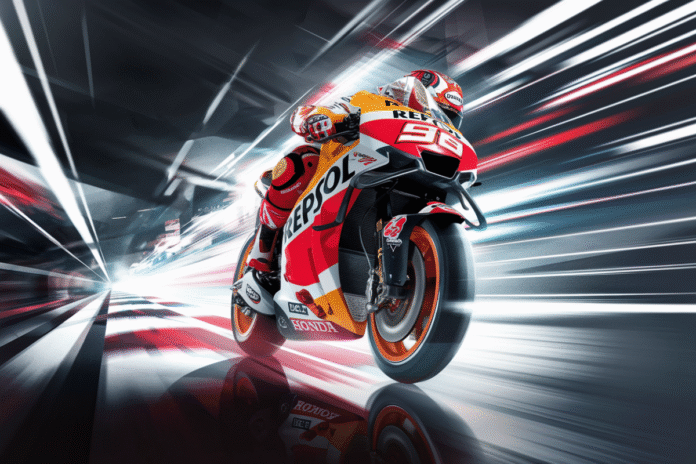“After decades of unwavering support, the landscape of motorcycle racing is set to shift dramatically.” This transition comes as Repsol, a titan in the world of motorsports, steps away from its long-standing partnership with Honda. The announcement has sent shockwaves through the racing community, raising questions about the future of both entities. With Repsol now poised to take the helm as the official partner of the Moto2 and Moto3 classes, the implications for the sport and its stakeholders are profound. What does this new chapter mean for the competitive landscape of motorcycle racing?
The stakes are high as Repsol embarks on this new journey. The company has been synonymous with Honda for decades, creating a powerful synergy that has defined the sport. As Repsol shifts its focus to Moto2 and Moto3, it opens the door to fresh possibilities and challenges. This partnership not only marks a significant change for Repsol but also for the teams and riders in these classes. As the racing world watches closely, the question remains: how will this impact the dynamics of competition, sponsorship, and the overall growth of motorcycle racing?
A New Era for Repsol in Motorcycle Racing
Repsol’s decision to transition away from its long-term partnership with Honda signifies a pivotal moment in the motorcycle racing industry. For decades, this collaboration has produced remarkable achievements, including numerous championships and milestones that have shaped the sport. The alliance has been characterized by a shared vision for innovation and excellence, making it one of the most recognizable partnerships in motorsport history. However, as Repsol shifts its focus to the Moto2 and Moto3 classes, it signals a strategic move aimed at expanding its influence and presence in the sport.
By aligning with Moto2 and Moto3, Repsol aims to tap into a burgeoning talent pool and foster the next generation of motorcycle racing stars. These classes serve as a critical stepping stone for riders aspiring to compete at the highest levels, including MotoGP. The opportunity to nurture young talent presents Repsol with the chance to create a lasting legacy while reinforcing its commitment to the sport. Additionally, this shift allows the company to diversify its sponsorship portfolio, potentially leading to new partnerships and collaborations that could reshape the racing landscape.
The implications of this strategic move extend beyond Repsol and its immediate partners. The shift in focus may alter the competitive dynamics within Moto2 and Moto3, attracting new sponsors and increasing visibility for the classes. As Repsol brings its extensive marketing expertise to these levels, the potential for growth is immense. The partnership could lead to enhanced media coverage, greater fan engagement, and increased investment in the sport, ultimately benefiting all stakeholders involved.
The Impact on Honda and the Racing Community
Honda’s longstanding partnership with Repsol has been a hallmark of success in motorcycle racing. The two entities have enjoyed a fruitful collaboration, marked by shared goals and achievements. However, as Repsol transitions to Moto2 and Moto3, the implications for Honda are significant. The absence of Repsol’s branding and support in the MotoGP class may challenge Honda to reevaluate its marketing strategies and partnerships moving forward.
Without Repsol, Honda may need to seek alternative sponsorships or reallocate its resources to maintain its competitive edge. This shift could lead to a more fragmented sponsorship landscape within the MotoGP paddock, as teams and manufacturers look to fill the void left by Repsol’s departure. The racing community will undoubtedly feel the effects of this transition, as teams adapt to the new dynamics and seek to forge their own paths in the absence of such a prominent partner.
Moreover, the competitive landscape within Moto2 and Moto3 may experience a ripple effect. As Repsol invests in these classes, other sponsors may follow suit, leading to increased competition for visibility and resources. This influx of investment could elevate the overall quality of racing, attracting more fans and media attention. The potential for a revitalized Moto2 and Moto3, fueled by Repsol’s commitment, could ultimately enhance the appeal of motorcycle racing as a whole.
Future Prospects for Motorcycle Racing
As Repsol embarks on this new partnership with Moto2 and Moto3, the future of motorcycle racing appears poised for transformation. The company’s commitment to nurturing young talent and investing in these classes could have far-reaching effects on the sport’s overall growth. With a focus on innovation and performance, Repsol has the potential to redefine the standards of excellence in motorcycle racing.
The investment in Moto2 and Moto3 also aligns with broader trends in the sport, where there is an increasing emphasis on developing new talent and enhancing the spectator experience. As Repsol brings its expertise in marketing and brand development to these classes, fans can expect a more engaging and dynamic racing environment. This could lead to heightened interest from sponsors, media, and fans alike, ultimately driving the sport’s popularity to new heights.
Looking ahead, the collaboration between Repsol and Moto2 and Moto3 may serve as a blueprint for future partnerships within the racing community. As other companies observe the potential benefits of investing in emerging talent and classes, we may witness a shift in how sponsorships are approached in the motorcycle racing world. The implications of Repsol’s strategic move could inspire a new wave of investment and innovation, setting the stage for an exciting future in motorcycle racing.


